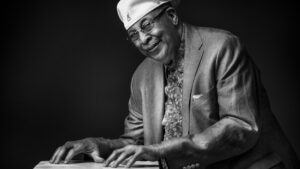There are any number of ways for you to be familiar with musician/composer and bandleader John Beasley. One could be through his work as a musician performing with Miles Davis, Freddie Hubbard, Dianne Reeves, Carly Simon, Steely Dan and more.
Or perhaps you know the MONK’estra that celebrates the music of Thelonious Monk and has also recorded Beasley’s music. Which gives us another way to know him – through his compositions. Some of that work having appeared in his work as a composer/arranger for film and television.
One of his biggest projects is his collaboration with legendary jazz musician and composer Chucho Valdés on the over hour-long opus La Creación. It’s a three-movement suite that explores the Afro-Cuban religion Santería and the creation story of Regla de Ocha.
The work had its world premiere in Paris last year. Valdés starts a short US tour this Wednesday at the Hollywood Bowl where La Creación will be performed. Beasley, along with co-arranger/music director Hilario Durán, will be on stage with Valdés, MONK’estra and the Yoruban band. After Los Angeles La Creación will be performed at the Paramount Theatre in Oakland on September 22nd, the Monterey Jazz Festival on September 23rd, The Rose Theatre in New York on October 7th and 8th, Berklee Performance Center in Boston on October 14th, the Kennedy Center on October 16th and the Chicago Symphony Center on October 18th.
Last week I spoke with Beasley about Valdés and the creation of La Creación. What follows are excerpts from our conversation that have been edited for length and clarity. To see the full interview, please go to our YouTube channel.

Chucho Valdes is quoted as saying about La Creación, “This work is very significant to me. I think it’s my masterpiece – so far.” What does that tell you about this legendary musician and composer that, as he approaches the age of 81, he’s still thinking forward by saying “so far?”
The guy lives and breathes music. He told me during the pandemic he was still practicing 6 to 8 hours a day: couple of hours in the morning, a couple hours after lunch, a couple hours after dinner.
So that tells me something right there. He’s still interested and still wanting to get better.
When in the creation of La Creación did you first get involved and what was your first reaction to the music?
I got involved before he even started writing. It was January of 2020 and it was supposed to be premiered that fall in Paris. Of course, the pandemic happened. So he didn’t really start writing again until 2021. At first I thought it was going to be an opera – the story of of rhythm from the Yoruban culture to the Cuba Santeria up through New York to jazz up till now. It’s turned into this suite now which I think is a lot more interesting and easier to travel with for sure. He approached me about arranging it and orchestrating it in New Orleans that year. He sent me a lead sheet and he said, “Just go, man, you know, just do your thing.” And so I started working on it and marked it up for him in Sibelius and sent it back and we went back and forth a few times.He pretty much gave Hilario and I free rein in a way.
How much of the score is formally written?
It’s a jazz piece. The solos are all improvised. The first movement is a long sort of prayer, if you will, a call and that’s improvised with me and Chucho and the rhythm section. That’s probably 10 minutes at least right there; sort of a free thing. That really mixes modern elements, synthesizers with the original Santería religious ceremony. There’s a long extended percussion, solos and drum solos, and then Chucho is playing a lot.
In an interview with Jazz Times you told a story of playing next to Herbie Hancock at the Bowl and watching him get lost in the music. You said that lesson inspired you to be “sort of lost as an arranger….to arrange like an improviser.” How did that mindset come into play for La Creación?

Sort of the same way. Chuco sent me basically a lead sheet with the melody, some lines, a tempo vibe and said, just go. So I learned the piece on the piano, kind of absorbed it, and then started imagining it in my head how things could go. The way I kind of imagine having the guitar ensemble mixed with Elvin Jones, that was super important for me because my two movements in the piece, other than the beginning are sort of the modern era.
I think Elvin is super African in the way he plays and I wanted to have that happening with the jazz beat and jazz waltz and stuff like that. So much of my arranging happens away from the computer and the piano. I like that because I don’t end up writing what I already know how to play.
What stands out to you about what Valdés has created with this work?
The breadth of it is more enormous. You put this many people together and have this vision of a local’s Santería ceremony. The ensemble with a full Latin jazz ensemble with a big band, two arrangers, two music directors, two other keyboard players. That’s a big job and to do it for his 80th birthday.
I’m still amazed with all the different stuff he does all the time. We premiered in Paris and the next day we did a whole different show of a birthday celebration show, you know, with different people, different music. It’s just amazing, you know? He’s very gracious and he’s an amazing person. People are going to really sense his humanity, I think, when they see this piece.
Many people are not familiar with La Regla de Ocha which serves as the foundation for this work. What role does the music play in not just engaging the soul or the spirit, but also in explaining or demonstrating the religious traditions of Africa that came to Cuba in the early 19th century?
That’s really good. Well the slave trade, number one, that still has to be illuminated. People still don’t get that. It’s heartbreaking. Number two, you can’t eliminate the fact the reason why the African diaspora in the States sounds different. That’s because the slave owners didn’t allow drumming. They were afraid of it. So gospel music happens. After slavery reconstruction instruments, European instruments become what we call jazz and R&B and gospel music.
And in Brazil sort of the same thing happened. The ideal of superimposing African deities onto Christian saints. It’s all over Brazil, all over South America. The greatest thing about human suffering through all the setbacks is what’s survival with this soul intact? This beautiful art form survived all that horror. That’s amazing. It’s amazing that there’s not as much bitterness and anger as there certainly could be.
Has La Creación been recorded? If not, would a live setting be more faithful to the spirit of the work than a studio recording?
That’s interesting because it evolves every night. Every night is different. You could argue that a live recording would be really great because we feed off the audience. There’s a lot of moving parts, it’s a large ensemble, so getting everybody in one place is sort of a challenge. Something about that live energy would be great.
On the other hand, to work on multiple takes and and punch in certain sections to really make it tighter or whatever. It’s not that the live thing is not tighter. It’s just a different animal, you know? You have a lot more control in the studio. Get a nice mix going. I don’t know if there’s an answer to that.
I want to conclude our conversation by asking you about something that Thelonious Monk said. He said, “Whatever you think can’t be done, somebody will come along and do it. A genius is the one most like himself.” What have you and Chucho Valdés and Hilario Durán accomplished with La Creación and how do you think your work has allowed you to be the most like yourself? And perhaps by extension, according to Monk, a genius.

The gift that Chucho gave Hilario and us to take his music and do our thing is to be ourselves. It starts at the top. Chucho knows that. He’s a true artist and he knows exactly what you’re saying. And he knows that to get the best out of somebody in his own work he has to give up a part of himself and let it pay forward to the next step of the process. He did that and that’s a lesson.
That’s one of the best things about leading a big band is the pressure’s off me sometimes. There’s so many great musicians in the band to let them go and do their thing and embrace the music as they hear it. You can have fun and and sort of expand on what they’re doing and be yourself. Does that make sense?
It does make sense. So do you think Chucho Valdés is a genius?
Geniuses. Listen to how he plays and how he communicates. He doesn’t sound like anybody else. He can sound like other people, but at this age it’s just pure. Somehow it’s just coming up here. Monk can say this, but Monk also put tons of hours into this. So has Chucho. You can have that the talent of a genius. But unless you put the hours in the flow of the genius will not be the same.
To see the full interview with John Beasley, please go here.
Main Photo: John Beasley (Photo by Scott Mitchell ©2012/Courtesy John Beasley)











